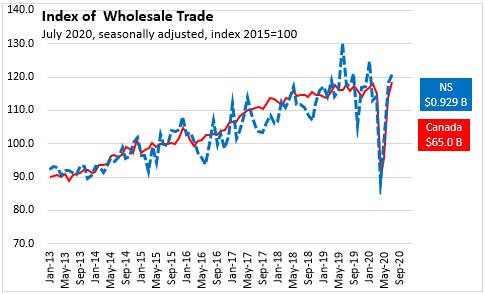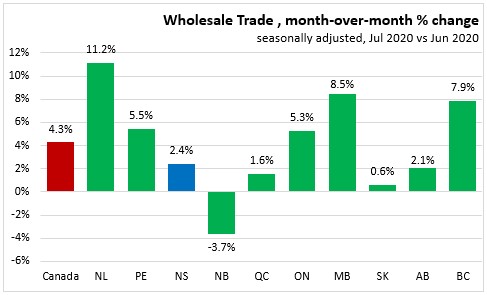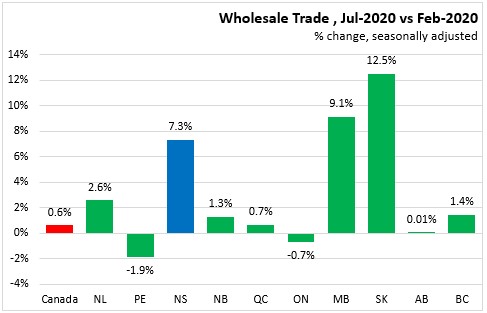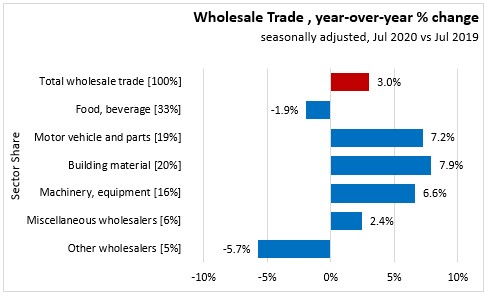The Economics and Statistics Division maintains archives of previous publications for accountability purposes, but makes no updates to keep these documents current with the latest data revisions from Statistics Canada. As a result, information in older documents may not be accurate. Please exercise caution when referring to older documents. For the latest information and historical data, please contact the individual listed to the right.
<--- Return to Archive
For additional information relating to this article, please contact:
September 18, 2020WHOLESALE TRADE, JULY 2020 MONTH-OVER-MONTH

MONTH-OVER-MONTH
In Nova Scotia July 2020, on a seasonally adjusted basis
- month-over-month wholesale trade increased 2.4 per cent to $928.9 million over June 2020.
- year-over-year wholesale trade increased 3.0 per cent over July 2019.
In Canada July 2020, on a seasonally adjusted basis
- month-over-month wholesale trade increased 4.3 per cent to $65.0 billion over June 2020.
- year-over-year wholesale trade increased 0.7 per cent over July 2019.
BY PROVINCE
On a month over month basis, seasonally adjusted wholesale trade was up 4.3 per cent nationally. Nine provinces reported monthly increases in wholesale trade, with Newfoundland and Labrador (11.2 per cent) reporting the largest gain in percentage terms. Nova Scotia reported an increase (2.4 per cent) over the previous month. New Brunswick reported the only decline (3.7 per cent) over the previous month.

On a year-over-year basis, seasonally adjusted wholesale trade was up 0.7 per cent nationally. Seven provinces reported year-over-year increases in wholesale trade, with Manitoba (9.2 per cent) reporting the largest gain in percentage terms. Nova Scotia reported an increase (3.0 per cent) over the previous year. Compared to July 2019, Prince Edward Island reported the largest decline (6.4 per cent).

Compared to February 2020, seasonally adjusted wholesale trade was up 0.6 per cent nationally in July. Eight provinces had wholesale trade in July that exceeded February levels, with the largest percentage increase occurring in Saskatchewan (12.5 per cent). Nova Scotia wholesale trade in July was up 7.3 per cent over February. July wholesale trade in Prince Edward Island (-1.9 per cent) and Ontario (-0.7) was below February levels.

NOVA SCOTIA SECTORS
Year-Over-Year
Nova Scotia (Jul 2020 vs Jul 2019), total wholesale trade year-over-year increased 3.0 per cent ($27.3 million) over the same month last year.
- Food, beverage with a 33% share of wholesale trade decreased 1.9 per cent (-$6.0 million).
- Motor vehicle and parts with a 19% share increased 7.2 per cent (+$12.1 million).
- Building material with a 20% share increased 7.9 per cent (+$13.4 million).
- Machinery, equipment with a 16% share increased 6.6 per cent (+$9.3 million).
- Miscellaneous wholesalers with a 6% share increased 2.4 per cent (+$1.4 million).
- Other wholesalers with a 5% share decreased 5.7 per cent (-$2.9 million).


WHOLESALE INVENTORIES

Inventories continue their descent in July
Wholesale inventories declined 0.4 per cent to $90.1 billion in July.
"Five of seven subsectors reported lower inventories, with the machinery, equipment and supplies (-2.5%) and the motor vehicle and motor vehicle parts and accessories (-3.0%) subsectors posting the largest declines. Partially offsetting the decline was a 4.4% increase in inventories of personal and household goods. The inventory-to-sales ratio fell to 1.39 in July from 1.45 in June, the third consecutive decline, and also the lowest level since October 2018."
- Statistics Canada
STATISTICS CANADA QUOTES
COVID-19 recovery and impacts
"The wholesale sector has demonstrated considerable resiliency as the Canadian economy started to reopen in the midst of the COVID-19 pandemic. July's sales were 0.6% higher than the pre-COVID-19 level in February 2020. The recovery from the COVID-19-induced drop has been widespread in the wholesale sector, as most subsectors' sales have reached pre-pandemic levels. Five of the seven subsectors reported sales in July that were higher than in February, led by the miscellaneous; machinery and equipment and supplies; and food, beverage, and tobacco subsectors. Excluding the motor vehicle and motor vehicle parts and accessories subsector, wholesale sales in July were 2.9% higher than in February."
"Provincially, wholesale sales were higher in eight provinces in July than February. Ontario and Prince Edward Island were the only provinces that had not returned to pre-COVID-19 levels. Ontario's delay was driven by sales in the motor vehicle and motor vehicle parts industry that were 13.4% below pre-COVID-19 levels in July. Saskatchewan, on the other hand, reaped the benefits of a strong agricultural supplies industry—whose sales did not drop below February's levels—ensuring that the province did not have a long row to hoe in its COVID-19 recovery. Saskatchewan's July sales were 12.5% higher than those in February."
- Statistics Canada
Reference Tables
20-10-0074-01 Seasonally adjusted Wholesale sales by province
20-10-0074-01 Nova Scotia seasonally adjusted Wholesale trade by NAICS sectors
20-10-0076-01 Canada seasonally adjusted Wholesale Trade Inventory
<--- Return to Archive